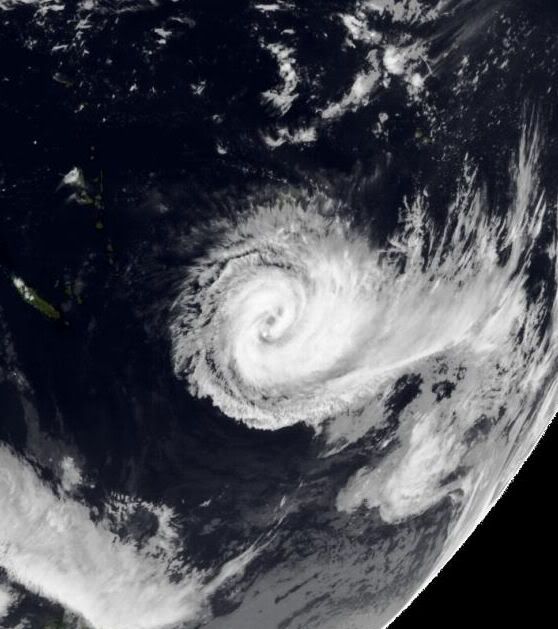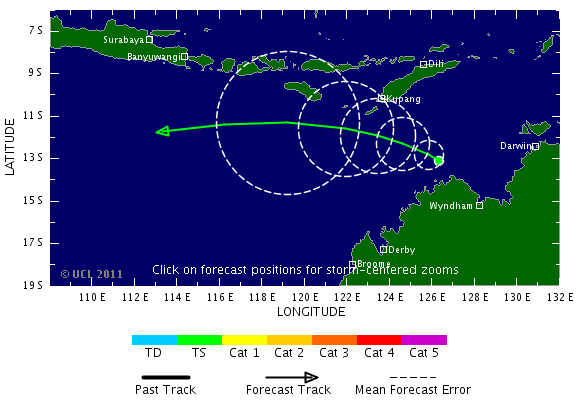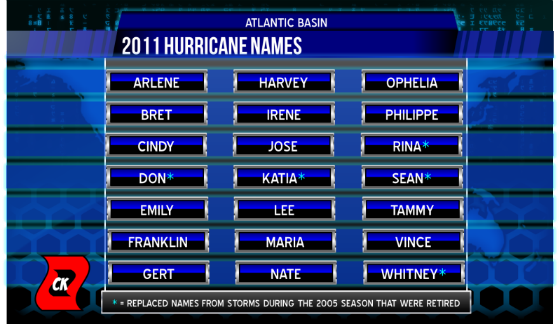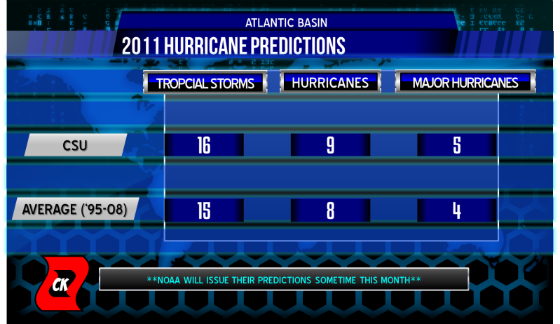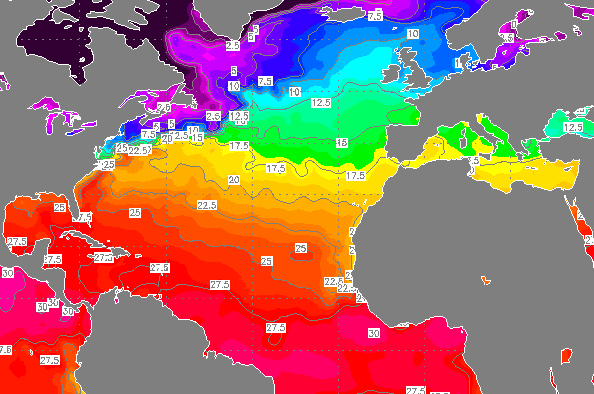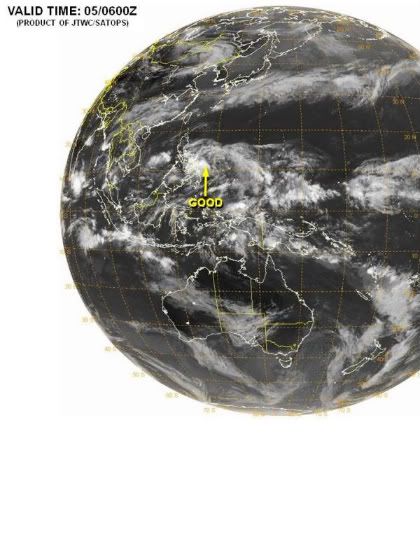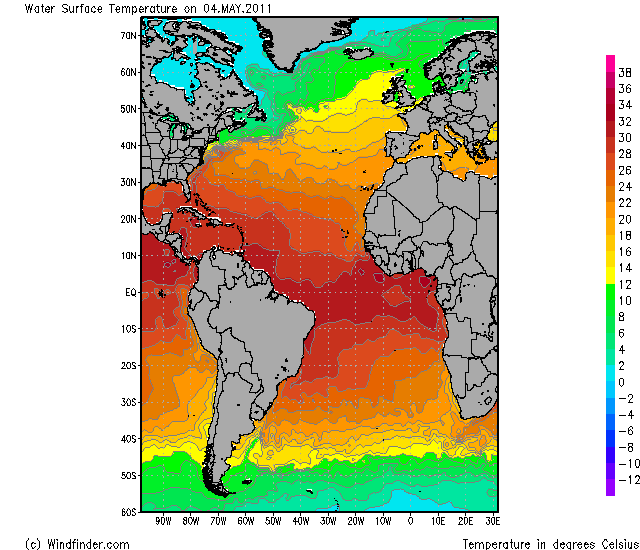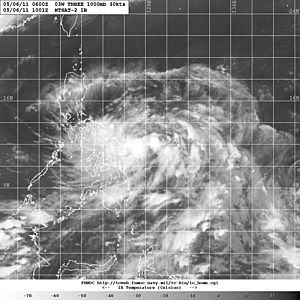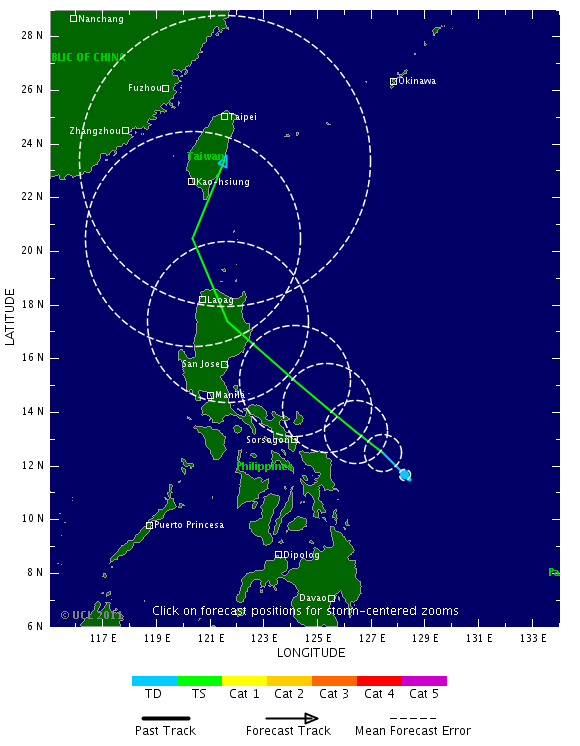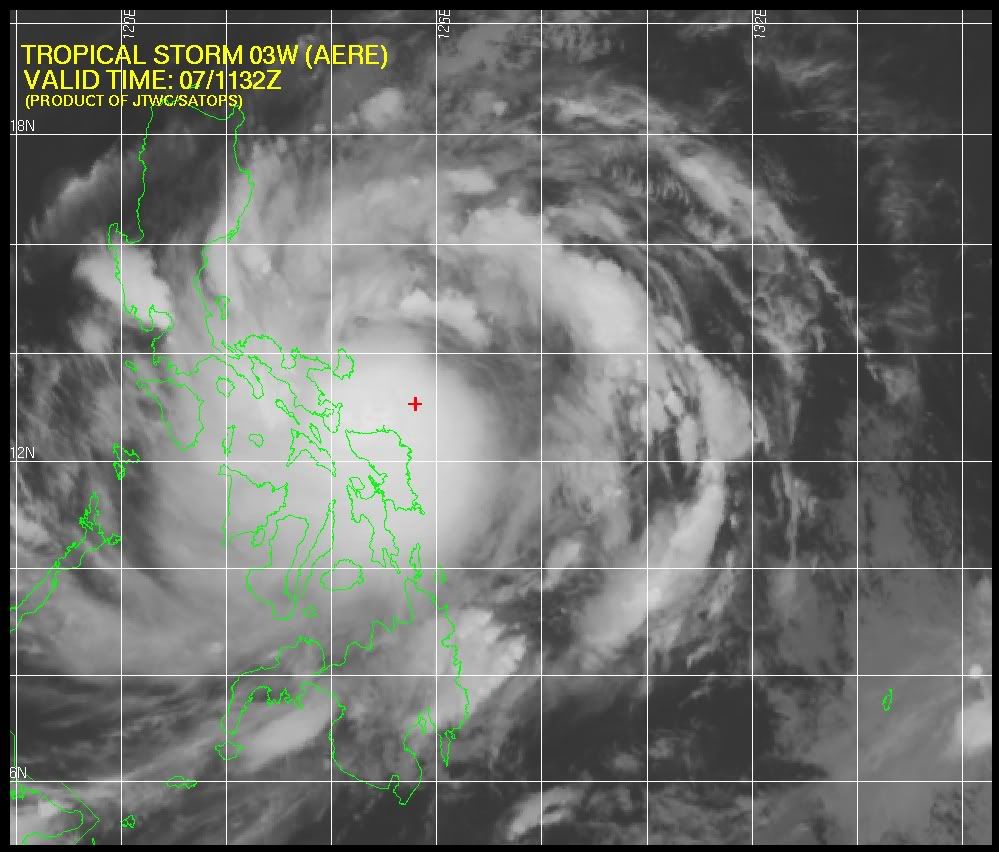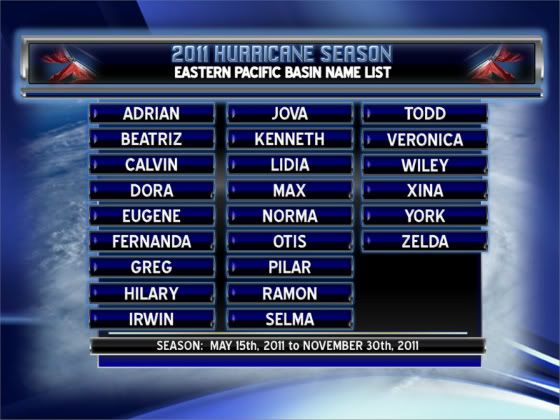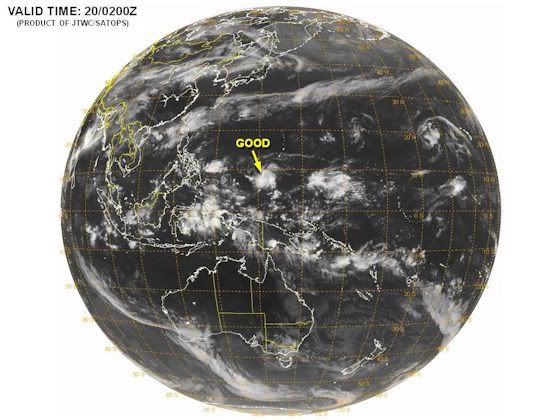WKN Weer, Klimaat en Natuurrampen
Lees alles over het onstuimige weer op onze planeet, volg orkanen en tornado's, zie hoe vulkanen uitbarsten en hoe Moeder Aarde beeft bij een aardbeving. Alles over de verwoestende kracht van onze planeet en tal van andere natuurverschijnselen.



Japan Typhoon Season: Will Disaster Areas be Hit?
While typhoon season doesn't typically ramp up around Japan until late summer, the threat of a tropical system affecting the fragile nation as it slowly recovers from the devastating earthquake and tsunami is a major concern.
Japan is located in the most active tropical basin in the world. Historically, tropical systems passing within 100 miles (160 km) of Sendai, Japan, an area hit hard by the earthquake and tsunami, have been observed as early as mid-June.
However, the threat of a tropical system affecting Japan usually becomes greatest in August and September, when ocean waters that far north are warmest, according to AccuWeather.com Expert Tropical Forecaster Dan Kottlowski.
In the western North Pacific Basin as a whole, typhoons and tropical storms can develop any time of the year, but the period from July through October is normally the most active.
This graphic displays the total number of tropical storms, as well as the number of those forecast to develop into typhoons and super typhoons, expected in the western North Pacific Basin in 2011 compared to the average number per year.
This year in the western North Pacific Basin, the AccuWeather.com Hurricane Center is forecasting a fairly average typhoon season with a total of 27 tropical storms, 16 of which will become typhoons and 4 of which will strengthen into super typhoons.
The definitions of a typhoon, super typhoon, tropical storm and tropical depression are given at the bottom of this page.
Odds of a Typhoon Hitting Japan Disaster Areas this Year
There are several good things going for the disaster areas of Japan in terms of the risk of impact from a typhoon. However, despite these positives, tropical systems do affect northern Japan with some regularity, and flooding rain tends to be the biggest problem.
One of the positives is that only a small percentage of tropical systems that develop in the western North Pacific basin impact northeastern Japan.
Out of the estimated 1,757 tropical storms and typhoons that have formed in the western North Pacific basin between 1945 and 2008, approximately 40 (2 percent) have tracked within 100 miles (160 km) of Sendai. Storm tracks are based on the movement of the center or eye of the storm.
The other positive is that, historically, typhoons that do affect northern Japan tend to be in a weakening phase and do not pose a significant damaging wind threat.
This is due in part to the fact that these typhoons have often already made landfall either in southern Japan or somewhere else in the western North Pacific basin. It is also due in part to the fact that waters over which these systems track are cooler offshore of northern Japan.
Of the 40 tropical systems that passed within 100 miles of Sendai between 1945 and 2008, 16 were of typhoon strength at some point within 100 miles of Sendai. None of those typhoons were stronger than a Category 2 hurricane when they entered the 100-mile radius.
In fact, all but one of those 16 typhoons had a strength equivalent to a Category 1 hurricane during that time.
This image, courtesy of the U.S. National Oceanic and Atmospheric Administration's Historical Hurricane Tracks database, shows the tracks of tropical systems that moved within a 100-mile radius of Sendai, Japan, between 1945 and 2008. Light blue represents systems in the stage of a tropical depression, while green depicts a stage as a tropical storm. The other colors represent typhoons, with yellow being Category-1 hurricane strength, orange Category-2 hurricane strength and red Category-3 hurricane strength.
Because tropical systems that affect northern Japan tend to be weaker, the threat of wind damage is not a major concern. This is especially true for the earthquake and tsunami-ravaged areas of northeastern Japan, where the topography is such that these areas tend to be protected from damaging winds.
While the chance of any given typhoon, especially one stronger than a Category 2 hurricane, impacting Sendai (and other locations throughout the disaster area) is extremely small, tropical systems do affect that area with some regularity.
From 1945 to 2008, tropical systems have passed within 100 miles of Sendai 29 out of the 64 years, which is almost half the total number of years. The longest period of time that went by without a tropical system passing within 100 miles of Sendai was 4 years.
So even if the disaster areas of Japan were to escape impact from a tropical system this year, history would suggest that a system will affect these fragile areas within the next several years.
The last time a tropical system tracked significantly close to Sendai was in 2009. So if history repeats itself, one would expect another system to affect that area by 2013.
If or when that happens, flooding rain will be the biggest threat.
What is a Typhoon?
A typhoon is essentially the same thing as a hurricane. Both terms are regionally specific names for a strong tropical cyclone with sustained winds of at least 74 mph (119 kph).
A super typhoon, as defined by the U.S. Joint Typhoon Warning Center, is a typhoon with maximum sustained winds of at least 150 mph (241 kph), which would be equivalent to strong Category 4 or a Category 5 hurricane.
The term tropical storm is a name for a weaker tropical cyclone with sustained winds between 39 and 73 mph (62-117 kph). A tropical depression is a tropical cyclone with sustained winds less than 39 mph.
Accuweather
While typhoon season doesn't typically ramp up around Japan until late summer, the threat of a tropical system affecting the fragile nation as it slowly recovers from the devastating earthquake and tsunami is a major concern.
Japan is located in the most active tropical basin in the world. Historically, tropical systems passing within 100 miles (160 km) of Sendai, Japan, an area hit hard by the earthquake and tsunami, have been observed as early as mid-June.
However, the threat of a tropical system affecting Japan usually becomes greatest in August and September, when ocean waters that far north are warmest, according to AccuWeather.com Expert Tropical Forecaster Dan Kottlowski.
In the western North Pacific Basin as a whole, typhoons and tropical storms can develop any time of the year, but the period from July through October is normally the most active.
This graphic displays the total number of tropical storms, as well as the number of those forecast to develop into typhoons and super typhoons, expected in the western North Pacific Basin in 2011 compared to the average number per year.
This year in the western North Pacific Basin, the AccuWeather.com Hurricane Center is forecasting a fairly average typhoon season with a total of 27 tropical storms, 16 of which will become typhoons and 4 of which will strengthen into super typhoons.
The definitions of a typhoon, super typhoon, tropical storm and tropical depression are given at the bottom of this page.
Odds of a Typhoon Hitting Japan Disaster Areas this Year
There are several good things going for the disaster areas of Japan in terms of the risk of impact from a typhoon. However, despite these positives, tropical systems do affect northern Japan with some regularity, and flooding rain tends to be the biggest problem.
One of the positives is that only a small percentage of tropical systems that develop in the western North Pacific basin impact northeastern Japan.
Out of the estimated 1,757 tropical storms and typhoons that have formed in the western North Pacific basin between 1945 and 2008, approximately 40 (2 percent) have tracked within 100 miles (160 km) of Sendai. Storm tracks are based on the movement of the center or eye of the storm.
The other positive is that, historically, typhoons that do affect northern Japan tend to be in a weakening phase and do not pose a significant damaging wind threat.
This is due in part to the fact that these typhoons have often already made landfall either in southern Japan or somewhere else in the western North Pacific basin. It is also due in part to the fact that waters over which these systems track are cooler offshore of northern Japan.
Of the 40 tropical systems that passed within 100 miles of Sendai between 1945 and 2008, 16 were of typhoon strength at some point within 100 miles of Sendai. None of those typhoons were stronger than a Category 2 hurricane when they entered the 100-mile radius.
In fact, all but one of those 16 typhoons had a strength equivalent to a Category 1 hurricane during that time.
This image, courtesy of the U.S. National Oceanic and Atmospheric Administration's Historical Hurricane Tracks database, shows the tracks of tropical systems that moved within a 100-mile radius of Sendai, Japan, between 1945 and 2008. Light blue represents systems in the stage of a tropical depression, while green depicts a stage as a tropical storm. The other colors represent typhoons, with yellow being Category-1 hurricane strength, orange Category-2 hurricane strength and red Category-3 hurricane strength.
Because tropical systems that affect northern Japan tend to be weaker, the threat of wind damage is not a major concern. This is especially true for the earthquake and tsunami-ravaged areas of northeastern Japan, where the topography is such that these areas tend to be protected from damaging winds.
While the chance of any given typhoon, especially one stronger than a Category 2 hurricane, impacting Sendai (and other locations throughout the disaster area) is extremely small, tropical systems do affect that area with some regularity.
From 1945 to 2008, tropical systems have passed within 100 miles of Sendai 29 out of the 64 years, which is almost half the total number of years. The longest period of time that went by without a tropical system passing within 100 miles of Sendai was 4 years.
So even if the disaster areas of Japan were to escape impact from a tropical system this year, history would suggest that a system will affect these fragile areas within the next several years.
The last time a tropical system tracked significantly close to Sendai was in 2009. So if history repeats itself, one would expect another system to affect that area by 2013.
If or when that happens, flooding rain will be the biggest threat.
What is a Typhoon?
A typhoon is essentially the same thing as a hurricane. Both terms are regionally specific names for a strong tropical cyclone with sustained winds of at least 74 mph (119 kph).
A super typhoon, as defined by the U.S. Joint Typhoon Warning Center, is a typhoon with maximum sustained winds of at least 150 mph (241 kph), which would be equivalent to strong Category 4 or a Category 5 hurricane.
The term tropical storm is a name for a weaker tropical cyclone with sustained winds between 39 and 73 mph (62-117 kph). A tropical depression is a tropical cyclone with sustained winds less than 39 mph.
Accuweather


2011 Atlantic Hurricane Season will be Active, Have more US Landfalls
AccuWeather.com Hurricane Center meteorologists, led by Meteorologist and Hurricane Forecaster Paul Pastelok, are predicting an active season for 2011 with more impact on the U.S. coastline than last year.
The team is forecasting a total of 15 named tropical storms, eight of which will attain hurricane status and three of which will attain major hurricane status (Category 3 or higher).
In a normal year, there are 10 tropical storms, six of which become hurricanes and two of which become major hurricanes, or attain winds that exceed 110 mph.
2010's historic season had a total of 19 named storms and ranks as the third most active season on record, but there was little impact on the United States coastline. Twelve of these storms became hurricanes, five of which were major hurricanes. Two names from the 2010 season were retired on March 16.
"It looks like we're going to have more impact on the mainland of the U.S. coming up this year compared to last year," Pastelok said. "We had a lot of storms last year, but not a lot of impact [on the U.S.]."
In order to project the number of storms and impacts, the team looks at past years that have similar weather variables and patterns that closely resemble the most recent fall, winter and early spring months.
Factors for this Season
There are a number of physical drivers that have the team concerned for this upcoming hurricane season. These include:
--The orientation and position of the Azores and Bermuda high-pressure areas in the Atlantic
The Azores high is one of the bigger influences on the movement of tropical cyclones. High pressure systems alter the direction of a storm by steering the storm, a low pressure system, around it. This is one way forecasters can predict the track of a hurricane.
"The forecast position and strength of the Azores or Bermuda high is always a challenging forecast," Pastelok said. "An unexpected change could greatly alter where both early season and mid season storms track."
AccuWeather.com Expert Tropical Forecaster Dan Kottlowski added, "We do see some changes in the overall pattern across the Atlantic."
Kottlowski continued, "The water temps are not nearly as warm as they were last year, and also the upper air pattern looks slightly different... than last year, so that could have an impact as to where that subtropical high, that big high pressure area that helps guide tropical storms, sets up."
"It may weaken or actually reposition itself a little bit to the northeast as we get later in the season, which would allow more of a storm track closer to Florida and also up the East Coast," Kottlowski concluded.
--The future state of the ongoing La Niña
La Niña is a phenomenon that occurs when the surface waters in the central and eastern equatorial Pacific are colder than normal. La Niña results in low wind shear, especially in the main tropical development area in the Atlantic. Shear refers to strong winds that are high in the atmosphere. Wind shear is a "hurricane killer," in that it can hinder storm development as well as break up existing storms.
"Currently, right now we still are in a La Niña scenario, but it is starting to weaken," Pastelok said. "The signal is starting to show some signs of going neutral. That could have an impact on the westerly wind component down in the tropical Atlantic as well as the Caribbean. Stronger westerlies would prohibit major storms or a lot of storms, so it is a critical factor."
--The frequency and amount of dust that accompanies disturbances moving off the African coast
The presence of dust indicates dry air, which can hinder tropical development in the eastern Atlantic.
"Current projections on the weather pattern over Africa for this coming tropical season suggests there will be episodes of dust affecting development, but no more than normal," Pastelok said.
--A phenomenon known as Atlantic Multidecadal Oscillation (AMO)
AMO refers to the sea surface temperature in the northern Atlantic, and the temperature fluctuates from colder than average to warmer than average every few decades. Currently, the sea surface temperature is in the warm phase, and warm water is "hurricane fuel," in that it supports the development of tropical systems.
"We continue to observe the positive phase of the Atlantic Multidecadal Oscillation," said Paul Pastelok. "This will help to maintain warmer-than-normal water temperatures across most of the Atlantic Basin."
This Season's Concern Areas
As with most Atlantic hurricane seasons, the areas where storms are most likely to make landfall shift as the season progresses.
This year, the early season threat area will be the western Gulf of Mexico and the southern portion of the Caribbean. Within this zone, the higher concern for landfalls will be along the Texas and Louisiana coastlines.
As for the mid-to-late season zones, the eastern Gulf and Caribbean will be the focus. The higher concern areas will be the Florida Peninsula to the Carolinas.
"What we see is there is a clustering of storm impacts over the southeastern US, and that's the reason why we earmarked this as a concern area," said Kottlowski.
Another mid-to-late season concern for landfalls will be northern New England and the Canadian Maritimes.
"We feel that this season, there will be a higher potential for impacts across the southern part of the Basin into the Gulf of Mexico during the first part of the season," Pastelok stated. "This higher potential for impacts shift farther north into the southeast U.S. during the latter half of the season."
Hurricane season officially begins June 1 and ends Nov. 30.
For all the latest tropical information, be sure to check the AccuWeather.com Hurricane Center for the most up-to-date videos, information and storm tracks.
AccuWeather.com Hurricane Center meteorologists, led by Meteorologist and Hurricane Forecaster Paul Pastelok, are predicting an active season for 2011 with more impact on the U.S. coastline than last year.
The team is forecasting a total of 15 named tropical storms, eight of which will attain hurricane status and three of which will attain major hurricane status (Category 3 or higher).
In a normal year, there are 10 tropical storms, six of which become hurricanes and two of which become major hurricanes, or attain winds that exceed 110 mph.
2010's historic season had a total of 19 named storms and ranks as the third most active season on record, but there was little impact on the United States coastline. Twelve of these storms became hurricanes, five of which were major hurricanes. Two names from the 2010 season were retired on March 16.
"It looks like we're going to have more impact on the mainland of the U.S. coming up this year compared to last year," Pastelok said. "We had a lot of storms last year, but not a lot of impact [on the U.S.]."
In order to project the number of storms and impacts, the team looks at past years that have similar weather variables and patterns that closely resemble the most recent fall, winter and early spring months.
Factors for this Season
There are a number of physical drivers that have the team concerned for this upcoming hurricane season. These include:
--The orientation and position of the Azores and Bermuda high-pressure areas in the Atlantic
The Azores high is one of the bigger influences on the movement of tropical cyclones. High pressure systems alter the direction of a storm by steering the storm, a low pressure system, around it. This is one way forecasters can predict the track of a hurricane.
"The forecast position and strength of the Azores or Bermuda high is always a challenging forecast," Pastelok said. "An unexpected change could greatly alter where both early season and mid season storms track."
AccuWeather.com Expert Tropical Forecaster Dan Kottlowski added, "We do see some changes in the overall pattern across the Atlantic."
Kottlowski continued, "The water temps are not nearly as warm as they were last year, and also the upper air pattern looks slightly different... than last year, so that could have an impact as to where that subtropical high, that big high pressure area that helps guide tropical storms, sets up."
"It may weaken or actually reposition itself a little bit to the northeast as we get later in the season, which would allow more of a storm track closer to Florida and also up the East Coast," Kottlowski concluded.
--The future state of the ongoing La Niña
La Niña is a phenomenon that occurs when the surface waters in the central and eastern equatorial Pacific are colder than normal. La Niña results in low wind shear, especially in the main tropical development area in the Atlantic. Shear refers to strong winds that are high in the atmosphere. Wind shear is a "hurricane killer," in that it can hinder storm development as well as break up existing storms.
"Currently, right now we still are in a La Niña scenario, but it is starting to weaken," Pastelok said. "The signal is starting to show some signs of going neutral. That could have an impact on the westerly wind component down in the tropical Atlantic as well as the Caribbean. Stronger westerlies would prohibit major storms or a lot of storms, so it is a critical factor."
--The frequency and amount of dust that accompanies disturbances moving off the African coast
The presence of dust indicates dry air, which can hinder tropical development in the eastern Atlantic.
"Current projections on the weather pattern over Africa for this coming tropical season suggests there will be episodes of dust affecting development, but no more than normal," Pastelok said.
--A phenomenon known as Atlantic Multidecadal Oscillation (AMO)
AMO refers to the sea surface temperature in the northern Atlantic, and the temperature fluctuates from colder than average to warmer than average every few decades. Currently, the sea surface temperature is in the warm phase, and warm water is "hurricane fuel," in that it supports the development of tropical systems.
"We continue to observe the positive phase of the Atlantic Multidecadal Oscillation," said Paul Pastelok. "This will help to maintain warmer-than-normal water temperatures across most of the Atlantic Basin."
This Season's Concern Areas
As with most Atlantic hurricane seasons, the areas where storms are most likely to make landfall shift as the season progresses.
This year, the early season threat area will be the western Gulf of Mexico and the southern portion of the Caribbean. Within this zone, the higher concern for landfalls will be along the Texas and Louisiana coastlines.
As for the mid-to-late season zones, the eastern Gulf and Caribbean will be the focus. The higher concern areas will be the Florida Peninsula to the Carolinas.
"What we see is there is a clustering of storm impacts over the southeastern US, and that's the reason why we earmarked this as a concern area," said Kottlowski.
Another mid-to-late season concern for landfalls will be northern New England and the Canadian Maritimes.
"We feel that this season, there will be a higher potential for impacts across the southern part of the Basin into the Gulf of Mexico during the first part of the season," Pastelok stated. "This higher potential for impacts shift farther north into the southeast U.S. during the latter half of the season."
Hurricane season officially begins June 1 and ends Nov. 30.
For all the latest tropical information, be sure to check the AccuWeather.com Hurricane Center for the most up-to-date videos, information and storm tracks.


Doden door tropische stormen in Bangladesh
(Novum/AP) - Noodweer heeft in Bangladesh aan zeker dertien mensen het leven gekost. Daarnaast hebben rond de honderd mensen verwondingen opgelopen toen zes districten in het noorden van het land maandagavond door tropische stormen geteisterd werden.
In het getroffen gebied werden honderden onderkomens door de krachtige slagregens verwoest. Enkele duizenden mensen zijn dakloos geraakt. Dit hebben de Bengalese media dinsdag gemeld.
Nieuws.nl
(Novum/AP) - Noodweer heeft in Bangladesh aan zeker dertien mensen het leven gekost. Daarnaast hebben rond de honderd mensen verwondingen opgelopen toen zes districten in het noorden van het land maandagavond door tropische stormen geteisterd werden.
In het getroffen gebied werden honderden onderkomens door de krachtige slagregens verwoest. Enkele duizenden mensen zijn dakloos geraakt. Dit hebben de Bengalese media dinsdag gemeld.
Nieuws.nl


Zo Het VWK en Paulus Pietsma komen er nu pas mee terwijl het artikel al een kleine vier maanden oud is
Hurricane Season 2011
Hurricane Season 2011
Weer of geen weer, altijd actueel www.onweer-online.nl


Nee dus 
quote:An area of thunderstorms about 1,200 miles from Southwest Florida — which has the official name of Invest 91— is highly unlikely to develop into any kind of named storm.
So says Jim Farrell, WINK News chief meteorologist. “Could even be gone by tomorrow,” Farrell said. “I don’t anticipate much happening.”
If history is any guide, the weather system will most certainly die out. Since 1851 there has been only one named storm in April, Tropical Storm Ana in 2003.
The storm is in an area of high wind shear.
“A very hostile upper air environment,” Farrell said.
At higher altitudes, winds are racing west to east, a strong inhibitor to further development.
“This is very typical for this time of the year,” Farrell said.
The storm is about 460 miles northeast of Puerto Rico in the Atlantic Ocean.
The National Hurricane Center in Miami gives the storm only a 20 percent chance for further intensification. The NHC reported that ships in the storm’s area reported gale-force winds near the center of the disturbance. That would put wind gusts in the 45-to-50 mile-per-hour range.


quote:A tropical disturbance (91L) near 24N, 63W, midway between the Virgin Islands and Bermuda, is moving north-northwest at about 8 mph. The system's heavy thunderstorm activity has increased since yesterday, but 91L has an elongated and poorly-organized circulation, thanks to a hefty 80 knots of wind shear. The storm is over waters of 25°C, and these waters will cool to 24°C by Friday as the storm continues to the north-northwest. Before 91L reaches Bermuda, steering currents will reverse and force 91L to the south-southwest on Saturday, into a region of higher wind shear. The latest SHIPS model forecast predicts wind shear will drop to 50 knots over 91L by Friday, then increase again to 70 knots by Sunday. The high shear and relatively cool water temperatures will make it difficult for 91L to organize into a subtropical depression. I give 91L a 10% of becoming a subtropical depression. Climatology argues against 91L becoming the first named storm of the year; there has only been once named April storm in the Atlantic since 1851, Tropical Storm Ana of 2003. The formation of a tropical disturbance at this location this time of year is unusual, but is not necessarily a harbinger of a active season ahead.


Hmm, heeft iemand een idee wanneer ze de eerste (echte) orkaan verwachten? kan er niet veel over vinden (ja, ik weet het, officieel begint het orkaan seizoen op 1 juni, maar wanneer verwachten ze de eerste orkaan?)


Dat is moeilijk te zeggen. Het seizoen kan vroeg beginnen, maar kan ook net als vorig jaar pas laat op gang komen.quote:Op dinsdag 3 mei 2011 14:06 schreef Floxxx het volgende:
Hmm, heeft iemand een idee wanneer ze de eerste (echte) orkaan verwachten? kan er niet veel over vinden (ja, ik weet het, officieel begint het orkaan seizoen op 1 juni, maar wanneer verwachten ze de eerste orkaan?)
Aan de zeewatertemperatuur zal het niet liggen...


Er van uit gaande dat je orkaan bedoeld (je schrijft ook (echte) erbij) en dus een Categorie 1 orkaan en geen tropische storm en/of depressies die ook namen krijgen dan is het volgens mij in de laatste dertig jaar niet voorgekomen dat er een Categorie 1 orkaan ontstond voor één juni. Misschien wel langer.quote:Op dinsdag 3 mei 2011 14:06 schreef Floxxx het volgende:
Hmm, heeft iemand een idee wanneer ze de eerste (echte) orkaan verwachten? kan er niet veel over vinden (ja, ik weet het, officieel begint het orkaan seizoen op 1 juni, maar wanneer verwachten ze de eerste orkaan?)
Ik zou op inzetten op de laatste week van juni voor de eerste Cat.1 Orkaan er is.


Ik doelde inderdaad op minimaal Cat 1, tropische stormen zijn niet zo interessantquote:Op dinsdag 3 mei 2011 16:47 schreef Frutsel het volgende:
[..]
Er van uit gaande dat je orkaan bedoeld (je schrijft ook (echte) erbij) en dus een Categorie 1 orkaan en geen tropische storm en/of depressies die ook namen krijgen dan is het volgens mij in de laatste dertig jaar niet voorgekomen dat er een Categorie 1 orkaan ontstond voor één juni. Misschien wel langer.
Ik zou op inzetten op de laatste week van juni voor de eerste Cat.1 Orkaan er is.
Ik woon namelijk in Florida en probeer er meestal wel een oogje op te houden, maar heb nooit echt nagekeken wanneer het nou echt begint :p


Laatste jaren is florida er redelijk ongeschonden vanaf gekomen denk ik?
wat dat betreft wordt het wel weer eens tijd
wat dat betreft wordt het wel weer eens tijd


Laatste zware orkaanseizoen voor Florida was in 2005 geloof ik, ik hoop dat het nog even uitblijft, maar ze verwachten een zwaar seizoen dit jaar, dus ben bang dat dat er niet in zit...quote:Op dinsdag 3 mei 2011 19:20 schreef Frutsel het volgende:
Laatste jaren is florida er redelijk ongeschonden vanaf gekomen denk ik?
wat dat betreft wordt het wel weer eens tijd


Dachten ze vorig jaar ook... toen werd het nada, noppes enzoquote:Op dinsdag 3 mei 2011 19:35 schreef Floxxx het volgende:
[..]
Laatste zware orkaanseizoen voor Florida was in 2005 geloof ik, ik hoop dat het nog even uitblijft, maar ze verwachten een zwaar seizoen dit jaar, dus ben bang dat dat er niet in zit...


Let's hope soquote:Op dinsdag 3 mei 2011 19:38 schreef Frutsel het volgende:
[..]
Dachten ze vorig jaar ook... toen werd het nada, noppes enzo


Een tropische storm kan voor flink wat ellende zorgen.quote:Op dinsdag 3 mei 2011 18:33 schreef Floxxx het volgende:
[..]
Ik doelde inderdaad op minimaal Cat 1, tropische stormen zijn niet zo interessant
Ik woon namelijk in Florida en probeer er meestal wel een oogje op te houden, maar heb nooit echt nagekeken wanneer het nou echt begint :p
Goed voorbeeld zijn de overstromingen in Australie begin dit jaar. Die werden veroorzaakt door een Tropische Storm...
Overstromingen Australie: Ergste in honderd jaar


Zo dan. Da's een nog grotere resevoir aan 30+ water dan in 2010. En uiteindelijk is dat toch de bak met energie die de orkanen moeten ledigen...quote:Op dinsdag 3 mei 2011 14:49 schreef aloa het volgende:
[..]
Dat is moeilijk te zeggen. Het seizoen kan vroeg beginnen, maar kan ook net als vorig jaar pas laat op gang komen.
Aan de zeewatertemperatuur zal het niet liggen...
[ afbeelding ]
Stiekem hoop ik op nog een Thomas die over Barbados heen scheert, en dat de instrumenten die we daar hebben staan het dan wel uithouden


Yasi, een monsterorkaan, kwam er toch ook nog overheen?quote:Op dinsdag 3 mei 2011 19:57 schreef aloa het volgende:
[..]
Een tropische storm kan voor flink wat ellende zorgen.
Goed voorbeeld zijn de overstromingen in Australie begin dit jaar. Die werden veroorzaakt door een Tropische Storm...
Overstromingen Australie: Ergste in honderd jaar


Die kwam inderdaad ook nog een aantal weken later.quote:Op donderdag 5 mei 2011 15:28 schreef Frutsel het volgende:
[..]
Yasi, een monsterorkaan, kwam er toch ook nog overheen?


En het is nog maar mei. Water is volgens mij vroeg op temperatuur.quote:Op donderdag 5 mei 2011 14:38 schreef thijsdetweede het volgende:
[..]
Zo dan. Da's een nog grotere resevoir aan 30+ water dan in 2010. En uiteindelijk is dat toch de bak met energie die de orkanen moeten ledigen...
Stiekem hoop ik op nog een Thomas die over Barbados heen scheert, en dat de instrumenten die we daar hebben staan het dan wel uithouden


Een collega voer afgelopen lente (precies rond dit moment) over de evenaar/langs de kaap verden, en toen was het water daar net boven de 30, dat was bijzonder. Toen ik hetzelfde tripje afgelopen oktober uitvoerde, was er eentje die wedde dat we de 30 wel zouden aantikken. Die heeft dus een ontbijt in volle duikuitrusting gedaan.quote:Op donderdag 5 mei 2011 18:53 schreef aloa het volgende:
[..]
En het is nog maar mei. Water is volgens mij vroeg op temperatuur.
[ afbeelding ]


Tropical Depression Develops, Threatens Philippines
An early-season tropical depression has formed east of the Philippines. Very heavy rain has begun to fall over central and northern areas of the nation and will continue to do so over the next several days.
Nearly 10 inches (250 mm) of rain has already fallen at Catarman as the center of the tropical depression remained just off the east coast.
The depression was moving slowly to the northwest at around 5 mph. Some slow strengthening into a tropical storm is likely over the next day or two before the center of the storm passes over northern Luzon Island in the northern Philippines early next week.
The main impact from this system will be localized flooding and strong winds, especially across eastern Luzon and eastern Visayas.
Daily rainfall totals can exceed 5 inches (125 mm) in many areas of central and northern Philippines, and could exceed 10 inches (250 mm) in a few locations. Widespread flooding will result, and could produce deadly mudslides.
Wind gusts can exceed 60 mph (95 kph) at the time of landfall over eastern Luzon Island. Landfall is expected late morning or early in the afternoon Monday, local time.
Accuweather
An early-season tropical depression has formed east of the Philippines. Very heavy rain has begun to fall over central and northern areas of the nation and will continue to do so over the next several days.
Nearly 10 inches (250 mm) of rain has already fallen at Catarman as the center of the tropical depression remained just off the east coast.
The depression was moving slowly to the northwest at around 5 mph. Some slow strengthening into a tropical storm is likely over the next day or two before the center of the storm passes over northern Luzon Island in the northern Philippines early next week.
The main impact from this system will be localized flooding and strong winds, especially across eastern Luzon and eastern Visayas.
Daily rainfall totals can exceed 5 inches (125 mm) in many areas of central and northern Philippines, and could exceed 10 inches (250 mm) in a few locations. Widespread flooding will result, and could produce deadly mudslides.
Wind gusts can exceed 60 mph (95 kph) at the time of landfall over eastern Luzon Island. Landfall is expected late morning or early in the afternoon Monday, local time.
Accuweather


Tropische storm eist minstens negen levens in Filipijnen
De tropische storm Aere heeft vandaag zeker negen levens geëist in het oosten van de Filipijnen. Vanwege de zware regenval en landverschuivingen zijn meer dan honderdduizend mensen geëvacueerd. Dat hebben de lokale autoriteiten bekendgemaakt.
Aere is de eerste grote storm dit jaar die het Zuidoost-Aziatische land aandoet. De storm trekt de komende uren naar Luzon, het grote eiland in het noorden. (anp/adv)
hln
De tropische storm Aere heeft vandaag zeker negen levens geëist in het oosten van de Filipijnen. Vanwege de zware regenval en landverschuivingen zijn meer dan honderdduizend mensen geëvacueerd. Dat hebben de lokale autoriteiten bekendgemaakt.
Aere is de eerste grote storm dit jaar die het Zuidoost-Aziatische land aandoet. De storm trekt de komende uren naar Luzon, het grote eiland in het noorden. (anp/adv)
hln


Meer doden in Filipijnen door noodweer
(Novum/AP) - MANILLA - De tropische storm Aere heeft in het noordoosten van de Filipijnen aan zeker elf mensen, onder wie een baby, het leven gekost. Meer dan honderdduizend mensen zijn op de vlucht geslagen uit angst voor aardverschuivingen.
De storm kwam zondag in de provincie Catanduanes aan land en bereikte windsnelheden tot 85 kilometer per uur. Op sommige plekken werden windstoten van meer dan 100 kilometer per uur gemeten.
Het noodweer veroorzaakte aardverschuivingen en overstromingen en zorgde voor stroomstoringen in verschillende steden. Bijna vijfduizend forenzen strandden in havens, omdat veerboten niet uitvoeren. Een groot aantal wegen was gesloten, omdat ze waren overstroomd of omdat er aardverschuivingen dreigden. Tevens werd een aantal binnenlandse vluchten geannuleerd.
De storm verplaatst zich naar verwachting richting het noordwesten om de archipel vervolgens te verlaten, aldus de meteorologische dienst.
nieuws.nl
(Novum/AP) - MANILLA - De tropische storm Aere heeft in het noordoosten van de Filipijnen aan zeker elf mensen, onder wie een baby, het leven gekost. Meer dan honderdduizend mensen zijn op de vlucht geslagen uit angst voor aardverschuivingen.
De storm kwam zondag in de provincie Catanduanes aan land en bereikte windsnelheden tot 85 kilometer per uur. Op sommige plekken werden windstoten van meer dan 100 kilometer per uur gemeten.
Het noodweer veroorzaakte aardverschuivingen en overstromingen en zorgde voor stroomstoringen in verschillende steden. Bijna vijfduizend forenzen strandden in havens, omdat veerboten niet uitvoeren. Een groot aantal wegen was gesloten, omdat ze waren overstroomd of omdat er aardverschuivingen dreigden. Tevens werd een aantal binnenlandse vluchten geannuleerd.
De storm verplaatst zich naar verwachting richting het noordwesten om de archipel vervolgens te verlaten, aldus de meteorologische dienst.
nieuws.nl


Dodental noodweer Filipijnen loopt op
MANILA (ANP/EFE) – Het dodental als gevolg van de tropische storm Aere op de Filipijnen is opgelopen tot dertien. Onder de slachtoffers zijn drie kinderen. Twee mensen worden vermist. Dat hebben de autoriteiten in het Aziatische land maandag gemeld. Eerder was melding gemaakt van negen doden.
De storm heeft vooral het oosten van de eilandengroep zwaar getroffen. Meer dan honderdduizend mensen daar zijn uit hun huizen verdreven door overstromingen en aardverschuivingen.
Het orkaanseizoen in Zuidoost-Azië begint doorgaans in mei of juni en houdt aan tot en met oktober of november. Gemiddeld krijgen de Filipijnen in die periode te maken met vijftien tot twintig gevaarlijke tyfonen.
bron
MANILA (ANP/EFE) – Het dodental als gevolg van de tropische storm Aere op de Filipijnen is opgelopen tot dertien. Onder de slachtoffers zijn drie kinderen. Twee mensen worden vermist. Dat hebben de autoriteiten in het Aziatische land maandag gemeld. Eerder was melding gemaakt van negen doden.
De storm heeft vooral het oosten van de eilandengroep zwaar getroffen. Meer dan honderdduizend mensen daar zijn uit hun huizen verdreven door overstromingen en aardverschuivingen.
Het orkaanseizoen in Zuidoost-Azië begint doorgaans in mei of juni en houdt aan tot en met oktober of november. Gemiddeld krijgen de Filipijnen in die periode te maken met vijftien tot twintig gevaarlijke tyfonen.
bron


This graphic displays the total number of tropical storms, as well as the number of those forecast to develop into typhoons and super typhoons, expected in the western North Pacific Basin in 2011 compared to the average number per year.


Tropische storm eist 24 doden op Filipijnen
De tropische storm Aere heeft 24 levens geëist op de Filipijnen. Dat hebben de autoriteiten laten weten.
De storm geselde de Filipijnen zondag en ging gepaard met stortregens.
Op het grote eiland Luzon moesten bijna 70.000 mensen hun huizen verlaten. Er is zware schade aan de landbouw: een eerste schatting spreekt van 2,7 miljoen dollar, of zo'n 1,87 miljoen euro.
De Filipijnen krijgen elk jaar een twintigtal tyfoons te verwerken. Sommigen richten veel schade aan en zorgen ook voor doden. (belga/vsv)
hln
[ Bericht 1% gewijzigd door #ANONIEM op 11-05-2011 09:20:54 ]
De tropische storm Aere heeft 24 levens geëist op de Filipijnen. Dat hebben de autoriteiten laten weten.
De storm geselde de Filipijnen zondag en ging gepaard met stortregens.
Op het grote eiland Luzon moesten bijna 70.000 mensen hun huizen verlaten. Er is zware schade aan de landbouw: een eerste schatting spreekt van 2,7 miljoen dollar, of zo'n 1,87 miljoen euro.
De Filipijnen krijgen elk jaar een twintigtal tyfoons te verwerken. Sommigen richten veel schade aan en zorgen ook voor doden. (belga/vsv)
hln
[ Bericht 1% gewijzigd door #ANONIEM op 11-05-2011 09:20:54 ]


Zondag 15 mei begint het orkaan seizoen in de Eastern Pacific. Er worden meer stormen met een naam verwacht dan vorig jaar. Vorig jaar waren er maar 7 stormen die een naam kregen.
Dit jaar worden er 15 stormen verwacht waarvan er 9 een naam zullen krijgen. 4 van deze stormen bereiken volgens de verwachting de major hurricane status. (Categorie 3 of meer)
Dit jaar worden er 15 stormen verwacht waarvan er 9 een naam zullen krijgen. 4 van deze stormen bereiken volgens de verwachting de major hurricane status. (Categorie 3 of meer)
quote:Hurricane Season Starts Sunday in Eastern Pacific
"Fifteen named storms would more than double the total from last year"
Sunday marks the official start of the 2011 hurricane season in the Eastern Pacific, a season which is expected to exceed the amount of named tropical systems from last year by twofold.
AccuWeather.com meteorologists are predicting an average number of tropical systems to develop in the Eastern Pacific this year.
The basin averages 15 tropical storms each season. Out of those, nine become hurricanes, with four reaching major hurricane status.
Fifteen named storms would more than double the total from last year. Only seven named storms formed in the Eastern Pacific in 2010, with three reaching hurricane status.
"Last year was... about as quiet as it can get," stated AccuWeather.com Western Expert Meteorologist Ken Clark.
"A strengthening La Niña can be partially attributed to the lack of tropical storms [last year]," reported AccuWeather.com Staff Writer Gina Cherundolo in her recap of the 2010 Eastern Pacific hurricane season.
A weakening La Niña, on the other hand, will bring the basin's hurricane season back to normal this year.
"The water [in the Eastern Pacific] will steadily warm, which will lead to lower pressure," stated AccuWeather.com Expert Senior Meteorologist Bob Smerbeck. Lower pressure will then open the door for the development of tropical systems.
"Since the pressure will remain slightly above average early in the season, we are not expecting a quick start," Smerbeck added.
There are clusters of thunderstorms currently streaming across the Eastern Pacific, but none show signs of future development.
The first tropical storm to develop in the Eastern Pacific this year will acquire the name "Adrian."
Hurricane season in the Eastern Pacific will run until November 30, which coincides with the end of hurricane season in the Atlantic Basin.
The 2011 Atlantic Basin hurricane season does not officially begin until June 1. The earlier start time in the Eastern Pacific reflects how this basin typically turns active faster than the Atlantic.
On average, June 9 is when the first tropical storm is named in the Eastern Pacific. In the Atlantic, that date is July 10.
Hurricanes typically develop much quicker in the Eastern Pacific than the Atlantic. The average first date for a hurricane to form in the Eastern Pacific is June 24, but not until August 14 in the Atlantic.
Despite the Eastern Pacific being rather active, the majority of tropical storms and hurricanes never threaten land. A typical Eastern Pacific tropical system will head westward into open and progressively cooler ocean waters, dissipating in the process.
Occasionally, tropical storms and hurricanes will target Mexico and parts of Central America. Though less frequently, some tropical systems have threatened Hawaii. Hurricane Felicia approached Hawaii in 2009, but weakened below tropical depression status prior to reaching the islands.
Since records began, the cool water that lies offshore of California has protected the state from direct hits by tropical storms and hurricanes in every year but one. In September 1939, an unnamed tropical storm pressed onshore at Long Beach, California with maximum sustained winds of 50 mph.
Two other storms have moved into Arizona at tropical storm strength. The first was once-Hurricane Joanne in October 1972, followed by once-Hurricane Kathleen in September 1976.
No systems have reached the Southwest at hurricane strength.


Dodental op de Filipijnen is opgelopen tot 31.
quote:Tropische storm Aere eist 31 levens op Filipijnen
De tropische storm Aere heeft op de Filipijnen al 31 mensen het leven gekost, zo hebben de autoriteiten laten weten.
De storm geselde de Filipijnen afgelopen zondag en ging gepaard met stortregens. Op het grote eiland Luzon moesten bijna 70.000 mensen hun huizen verlaten.
De Filipijnen krijgen elk jaar een twintigtal taifoens te verwerken. Sommige richten veel schade aan en zorgen ook voor doden.
hln


Ik denk dat we tot Selma komen 
Doe mee met het voorspellen van het weer!
Weekvoorspelling | Week 52 (invullen tot 22-12 - 11:59)
Maandvoorspelling December(Gesloten)
Jaarvoorspelling 2024 / 2025
Weekvoorspelling | Week 52 (invullen tot 22-12 - 11:59)
Maandvoorspelling December(Gesloten)
Jaarvoorspelling 2024 / 2025


ik dacht meer aan die ene, met MAXimum windspeeds up to 300km/uquote:Op maandag 16 mei 2011 00:51 schreef SoldMayor het volgende:
GREG en IRWIN klinken echt als cat.5 orkanen.


wundergroundquote:First tropical wave of the year over the Atlantic
The first tropical wave of 2011 is now over the tropical Atlantic near 6°N 46°W, according to the latest Atlantic Tropical Weather Discussion. The wave will bring heavy rain to the northeast coast of South America over the next two days, but is too far south to be a threat to develop into a tropical depression. The Atlantic hurricane season is just two weeks away, and the Eastern Pacific hurricane season began yesterday. So far, the models are not predicting any tropical storm development in the East Pacific or Atlantic over the next six days.


quote:Tropical Storm Aere formed in early May 2011, just east of the Philippines. Channel News Asia and Unisys Weather reported that the storm made landfall on May 8. By May 13, the Philippine government reported that the storm’s death toll in that nation stood at 31. Besides strong winds, the storm brought torrential rains that caused flash floods and landslides.
A color-coded image was created using data from NASA's Tropical Rainfall Measuring Mission (TRMM) satellite by Jesse Allen at NASA's Goddard Space Flight Center, Greenbelt, Md. The image shows estimated rainfall amounts from May 5 to 12, 2011. In the image, the lowest rainfall amounts (less than 75 millimeters, or 3 inches) appear in pale green, and the heaviest amounts (more than 600 millimeters, or 24 inches) appear in dark blue. The heaviest rainfall forms a kind of bull’s eye over the easternmost islands, southeast of Manila. Rainfall amounts fall farther away from this area, but rain still affects a broad swath across the central Philippines.
Over the course of its existence, Tropical Storm Aere traveled in a large arc. The storm passed over the northern Philippines, and passed east of Taiwan before curving back toward the northeast. Aere dissipated south of Japan.
Tropical storms and damaging rains frequently affect the Philippines, Typhoon Megi, Tropical Storm Conson, and Tropical Storm Ketsana being just a few of the storms to cause widespread damage. Torrential rains can also affect the islands even without the influence of named storms, such as heavy rains in January 2011.


PSU Atlantic hurricane season forecast: 16 named storms
Expect a busy Atlantic hurricane season this year, with sixteen named storms, say Pennsylvania State University (PSU) hurricane scientists Michael Mann and Michael Kozar. Their annual Atlantic hurricane season forecast issued on May 16 calls for 12 - 20 named storms this season, which starts June 1 and runs until November 30. An average season has 10 - 11 named storms. Their prediction was made using statistics of how past hurricane seasons have behaved in response to sea surface temperatures (SSTs), the El Niño/La Niña oscillation, the North Atlantic Oscillation (NAO), and other factors. This year's forecast is primarily based on three factors:
1) The current above-average sea surface temperatures in the Atlantic Main Development Region (MDR) for hurricanes, from Central America to the coast of Africa between 10°C and 20°C North latitude, will continue into the main part of hurricane season;
2) The fading La Niña event in the Eastern Pacific Ocean will be replaced by neutral El Niño/La Niña conditions;
3) The North Atlantic Oscillation (NAO) will be near average during hurricane season.
Figure 1. Hurricane Igor of 2010 as seen from the International Space Station.
The PSU team will also be making a new experimental forecast based not on the absolute MDR sea surface temperatures, but on difference between the MDR SST and ocean temperatures over the rest of the globe's tropical oceans. Some research has suggested that Atlantic hurricane activity is greater when this relative difference in SSTs is high, not necessarily when the absolute MDR SST is high (in other words, if all the world's tropical oceans have record high SSTs, we wouldn't get an unusually active Atlantic hurricane season, even with record warm SSTs in the Atlantic.) This new experimental forecast is predicting higher activity: 19 named storms in the Atlantic this year.
The PSU team has been making Atlantic hurricane season forecasts since 2007, and these predictions have done pretty well:
2007 prediction: 15 Actual: 15
2009 prediction: 12.5 Actual: 9
2010 prediction: 23 Actual: 19
NOAA will be issuing their annual pre-season Atlantic hurricane season forecast at 11:30am on Thursday, and I'll make a post on that Thursday afternoon. Tropical Storm Risk, Inc. (TSR) issues their pre-season forecast on May 24, and Colorado State University issues theirs on June 1.
Wunderground
Expect a busy Atlantic hurricane season this year, with sixteen named storms, say Pennsylvania State University (PSU) hurricane scientists Michael Mann and Michael Kozar. Their annual Atlantic hurricane season forecast issued on May 16 calls for 12 - 20 named storms this season, which starts June 1 and runs until November 30. An average season has 10 - 11 named storms. Their prediction was made using statistics of how past hurricane seasons have behaved in response to sea surface temperatures (SSTs), the El Niño/La Niña oscillation, the North Atlantic Oscillation (NAO), and other factors. This year's forecast is primarily based on three factors:
1) The current above-average sea surface temperatures in the Atlantic Main Development Region (MDR) for hurricanes, from Central America to the coast of Africa between 10°C and 20°C North latitude, will continue into the main part of hurricane season;
2) The fading La Niña event in the Eastern Pacific Ocean will be replaced by neutral El Niño/La Niña conditions;
3) The North Atlantic Oscillation (NAO) will be near average during hurricane season.
Figure 1. Hurricane Igor of 2010 as seen from the International Space Station.
The PSU team will also be making a new experimental forecast based not on the absolute MDR sea surface temperatures, but on difference between the MDR SST and ocean temperatures over the rest of the globe's tropical oceans. Some research has suggested that Atlantic hurricane activity is greater when this relative difference in SSTs is high, not necessarily when the absolute MDR SST is high (in other words, if all the world's tropical oceans have record high SSTs, we wouldn't get an unusually active Atlantic hurricane season, even with record warm SSTs in the Atlantic.) This new experimental forecast is predicting higher activity: 19 named storms in the Atlantic this year.
The PSU team has been making Atlantic hurricane season forecasts since 2007, and these predictions have done pretty well:
2007 prediction: 15 Actual: 15
2009 prediction: 12.5 Actual: 9
2010 prediction: 23 Actual: 19
NOAA will be issuing their annual pre-season Atlantic hurricane season forecast at 11:30am on Thursday, and I'll make a post on that Thursday afternoon. Tropical Storm Risk, Inc. (TSR) issues their pre-season forecast on May 24, and Colorado State University issues theirs on June 1.
Wunderground



